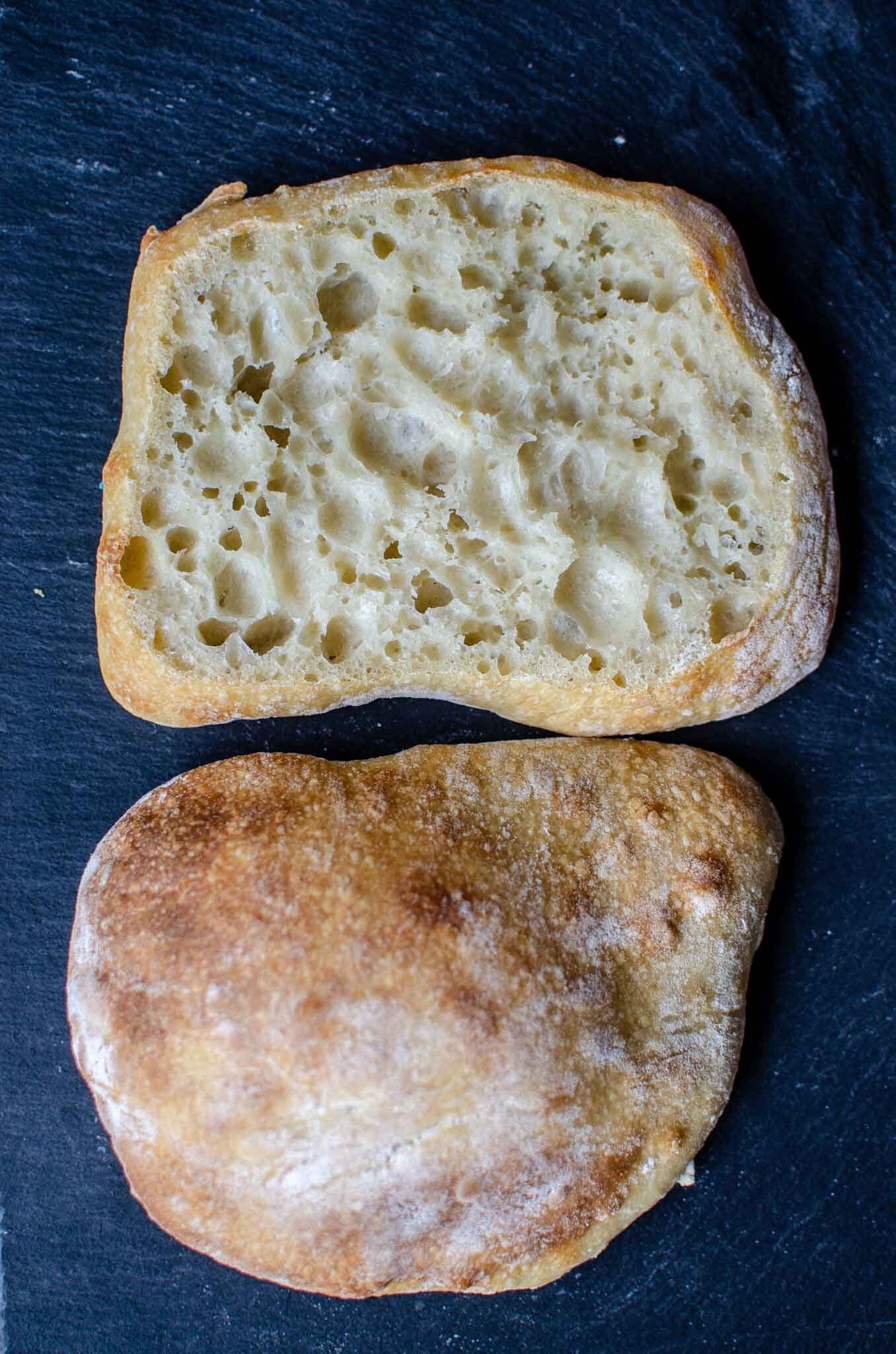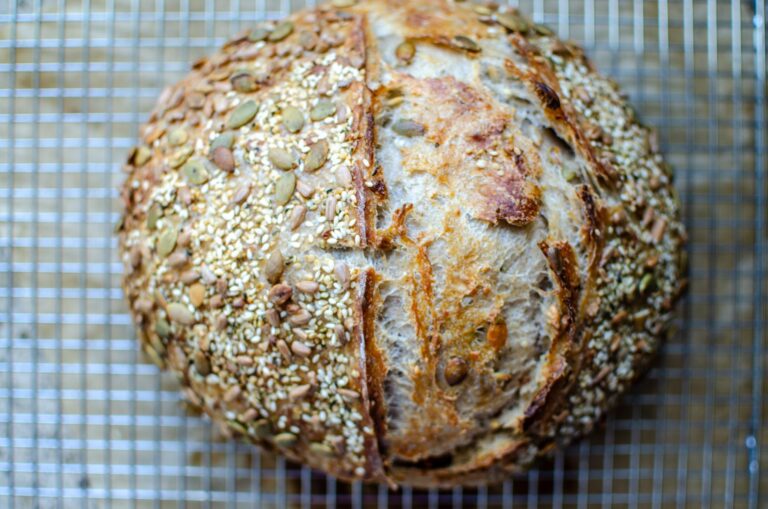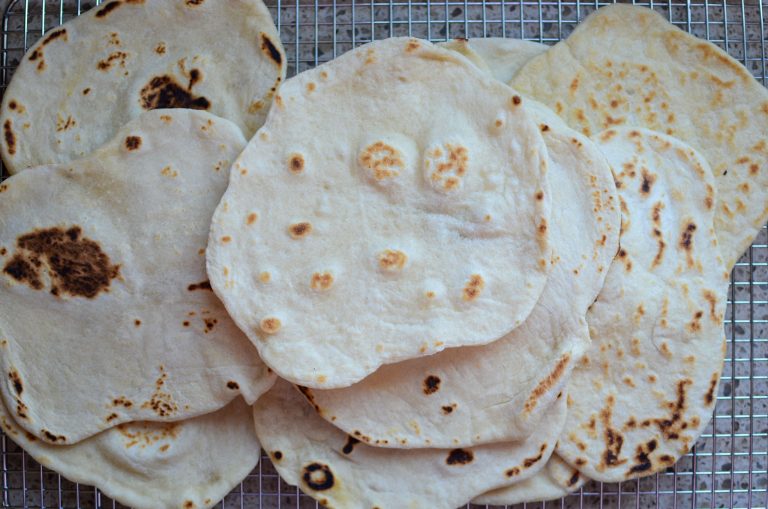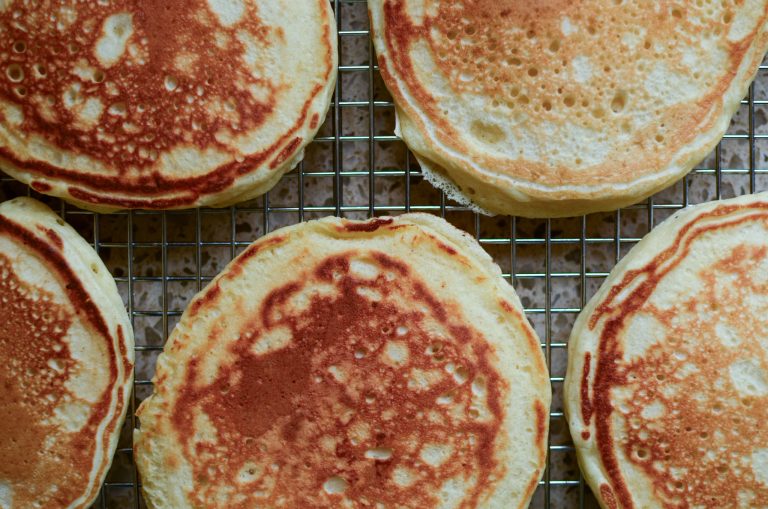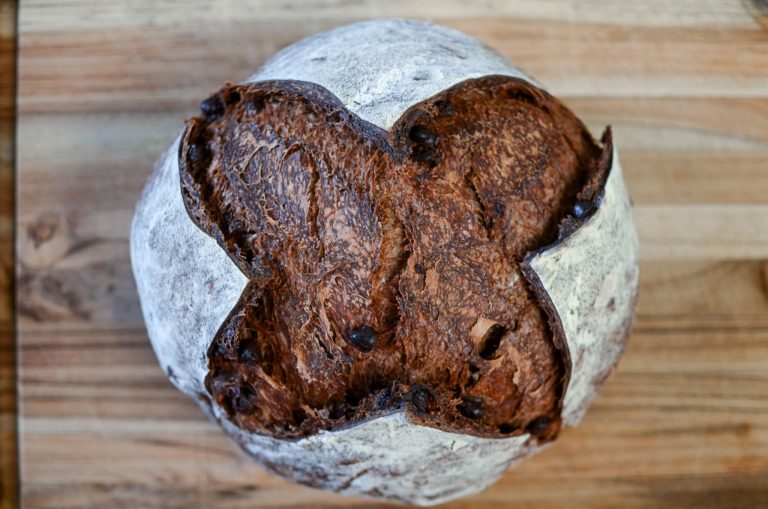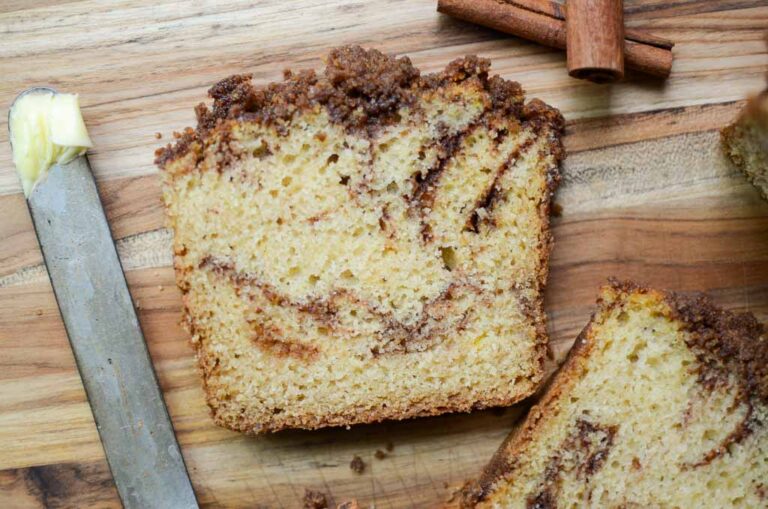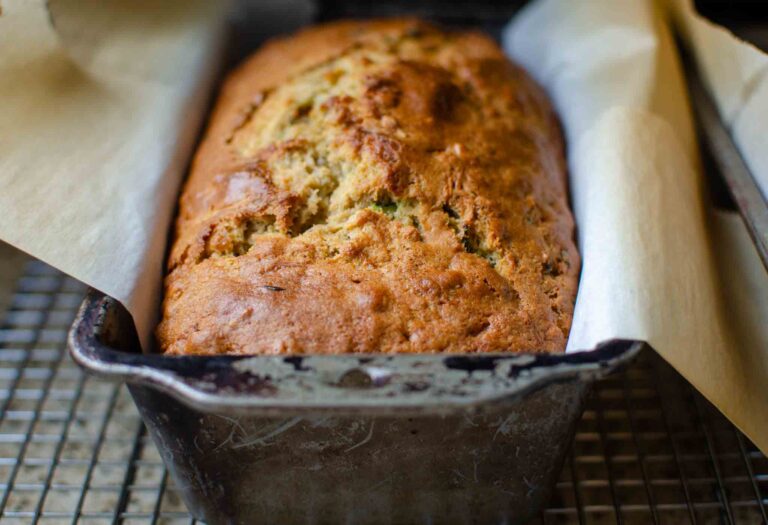Easy Sourdough Ciabatta Bread Recipe
This post may contain affiliate links. As an Amazon Associate, I may receive a small commission, at no cost to you, if you make a purchase. Please read our disclosure policy.
This easy sourdough ciabatta bread is a wonderful combination of a chewy, thin, crisp crust with a soft inside that’s full of open, irregular holes, making it simply delicious. Enjoying homemade ciabatta, fresh from the oven, is one of life’s simple pleasures.
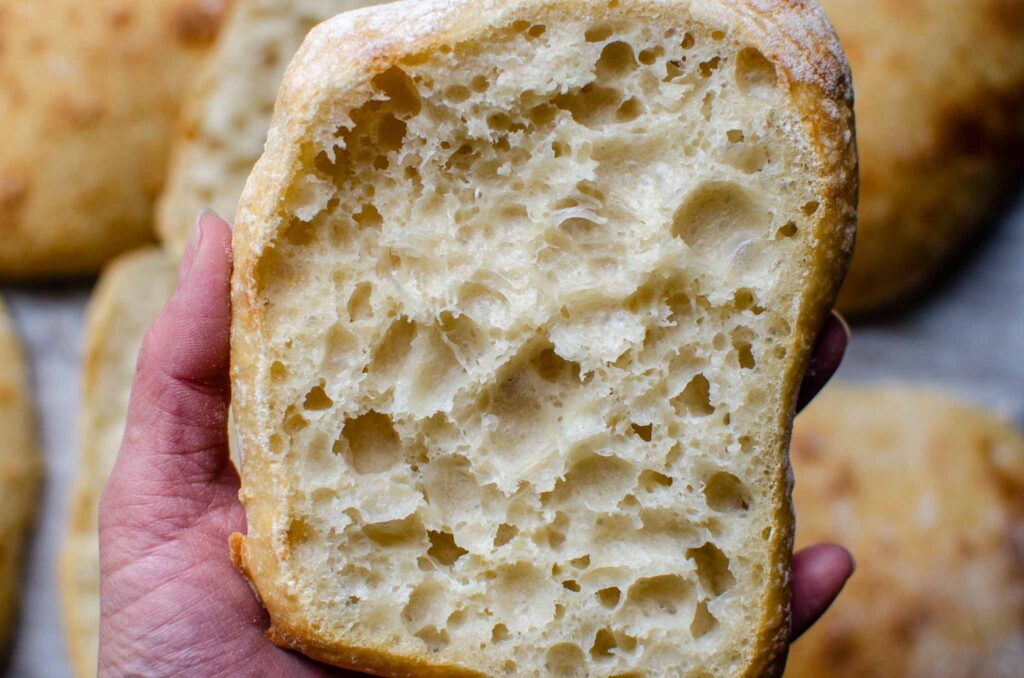
I’ve come to love crafting artisan breads. There’s something about enjoying a piece of fresh bread hot from the oven paired with a tall glass of cold brew. Knowing how to make these with my own hands brings me much joy.
This ciabatta is no exception! Especially with the anticipation of cutting a ciabatta roll open to see how airy and light it is inside.
Learn how to work with this wet dough with a sample schedule for a lovely baked sourdough ciabatta bread right at home.
Why You’ll Love This Recipe
- Airy crumb – Resembling Swiss cheese, the inside of ciabatta is known for its airy, open crumb due to it being a high hydration dough.
- Chewy texture – The flour covered crust has a beautiful chew to it.
- Sourdough flavor – Due to the long ferment, the sourdough ciabatta develops a lovely sourdough flavor.
- Versatile – Shape into individual size rolls that are perfect for making into sandwiches. Or keep it simple and shape the dough into long loaves.
What Are Sourdough Ciabatta Rolls?
Ciabatta means ‘slipper’ because of its long flat shape resulting from it being shaped and baked without a mold or bread pan. It’s a lovely, rustic Italian white bread.
Equipment
- Large bowl
- Kitchen scale
- Parchment paper or baker’s couches
- Pizza stone
- Stand mixer or dough whisk
Ingredients
- Sourdough Starter
- Warm Water
- Bread flour
- Salt
How to make Sourdough Ciabatta Bread
Feed Starter
You will need a ripe sourdough starter for this recipe. Feed the starter 4-8 hours before mixing your dough. The starter should show plenty of signs of life, be full of air bubbles, and have risen substantially. You know the starter is ready to use when it passes the float test. To do the float test, carefully take a teaspoon of the starter, trying not to knock any air bubbles out of it, and add it to a glass of water. If it floats, it’s ready. The starter has eaten and digested enough to produce carbon dioxide, thus making the starter full of gas and light enough to float.
Autolyze
Mix the flour and water into a large mixing bowl, making sure to incorporate all the dry flour in the bottom and sides of the bowl. Cover and allow to rest for 30 minutes so that the flour has time to properly hydrate.
Mix the Dough
Add the rest of the ingredients and mix well. If mixing by hand, I find that doing a combination of stretch and folds, along with squeezing the dough makes it easier to work the other ingredients into the autolyze. Continue to mix for a minute or two until all of the ingredients are well combined and then let the dough rest for 10 minutes.
A stand mixer makes quick work of this step instead of mixing by hand. Add the autolyze, starter, and salt to a stand mixing bowl and mix on medium for 10 minutes until the dough passes the windowpane test. It will be a smooth and elastic dough and really stretchy when the gluten has been properly developed. Skip the stretches and folds if using the stand mixer.
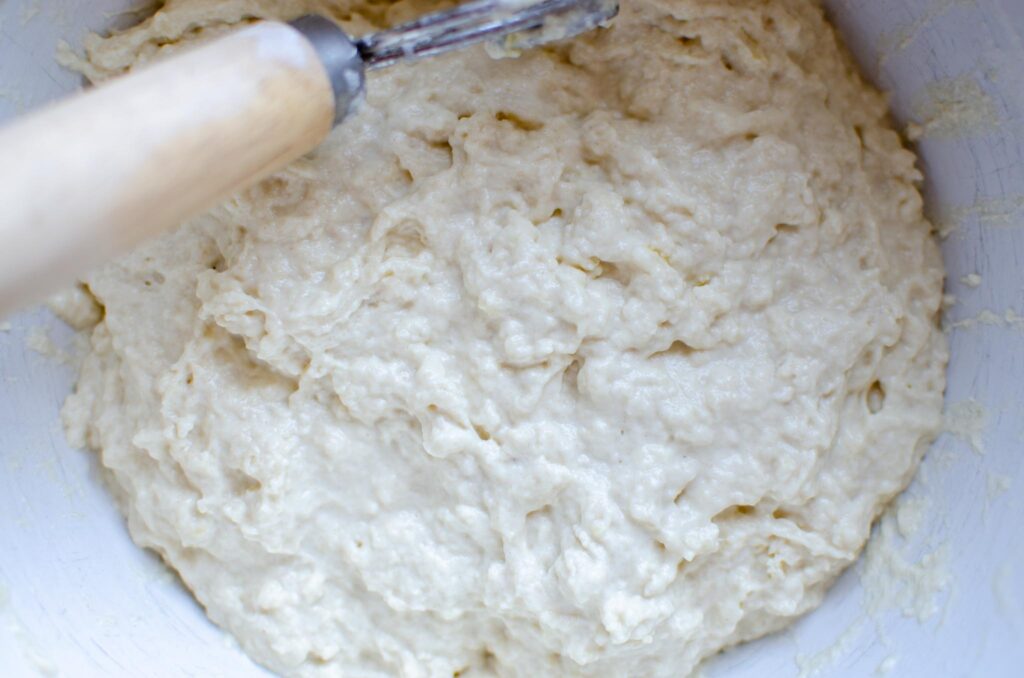
Stretch and Folds
Once rested, it’s time to start to stretch and fold the dough if mixing by hand. This is my preferred method, but it does take more time than using a stand mixer.
Grab a side of the dough and stretch it straight up 6-8 inches and then fold it over to the center of the dough. Rotate the bowl a quarter turn and do another stretch and fold. Continue stretches and folds until all of the dough has been worked and starts to become stiff. Let the dough rest 10 minutes and do another set of stretches and folds, performing 4-5 sets or until the windowpane test is passed.
The dough will gain strength and elasticity with each set of folds. Use wet hands if you find that the dough is too sticky.
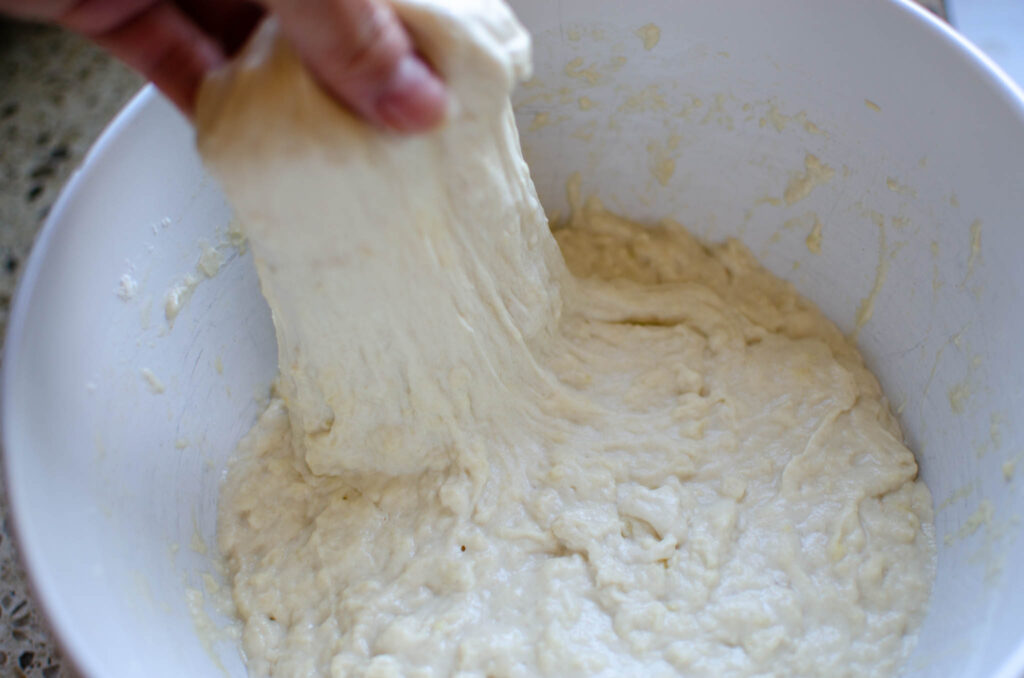
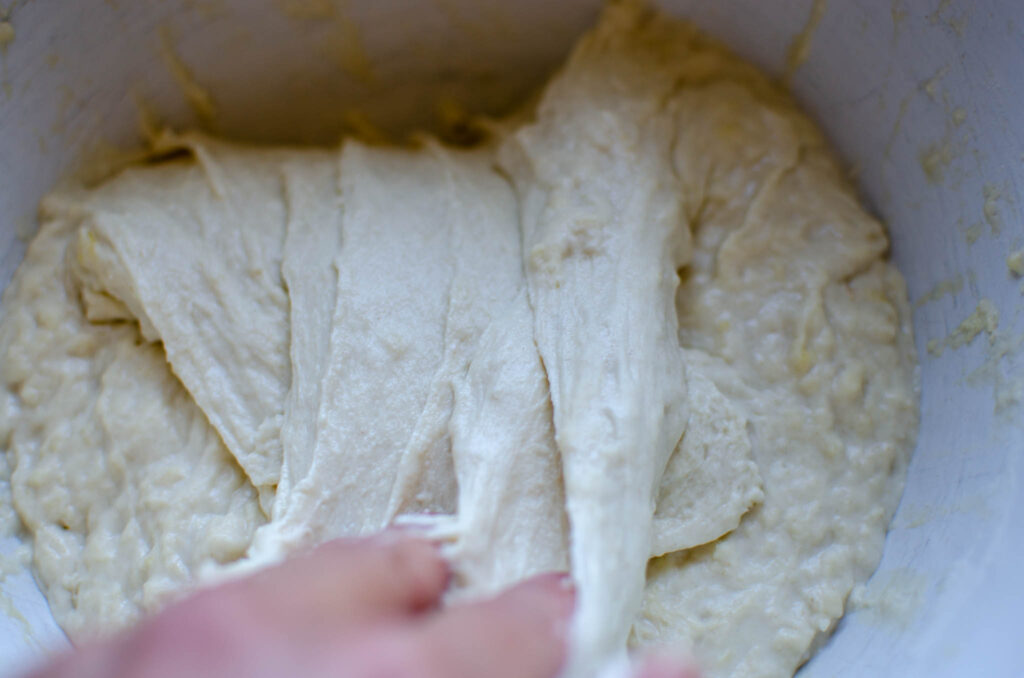
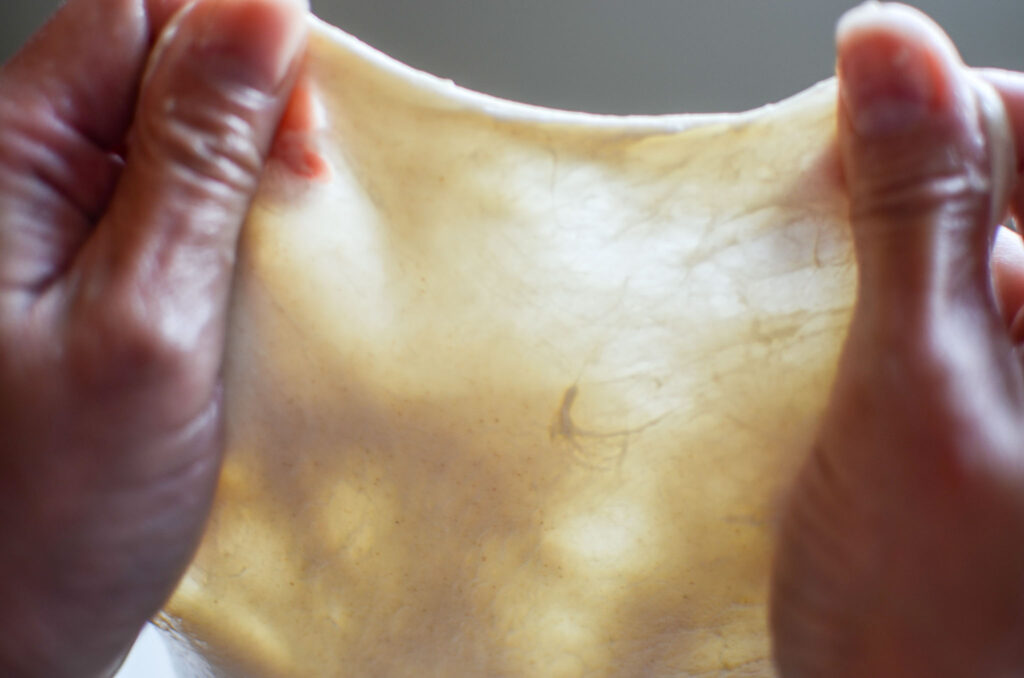
Window Pane Test
To know if the gluten is fully developed and strong enough to hold the air pockets as well as provide structure to your bread, it will pass the window pane test.
The dough is gently stretched in both hands up to the light. If you can stretch the dough thin enough that you can see through it, similar to a window pane, then it’s ready. If the dough breaks before being able to stretch thin enough, the gluten development isn’t quite there and it needs more stretch and folds.
Bulk Fermentation
Once the dough passes the window pane test, cover the bowl with a tea towel, plate or plastic wrap and allow to rest at room temperature until it has risen by 50 percent. For me this takes roughly 4-6 hours, but this time will largely depend on the temperature of your kitchen. A warmer kitchen means the bulk fermentation time will be shorter.
Cold Ferment
Move to the dough to the refrigerator and allow to cold ferment for 8-12 hours.
Divide and Shape
The next morning turn the dough out on a floured work surface, being careful to not knock out the air pockets with the sticky side up, gently pull the dough into a rectangular shape. It doesn’t need to be perfect. Remember that this is a rustic bread and that the variety of shapes just adds some charm. Dust the tops of the dough with flour. Using a bench scraper or dough knife, divide the dough into 6 equal pieces. Alternatively you can divide the dough down the center to create two loaves.
Use the bench scraper to lift the ciabatta roll onto a piece of parchment paper, making sure to leave plenty of space for each roll to rise and spread. Gently shape each roll to a rectangular shape for more even baking, but don’t fret over this step too much.
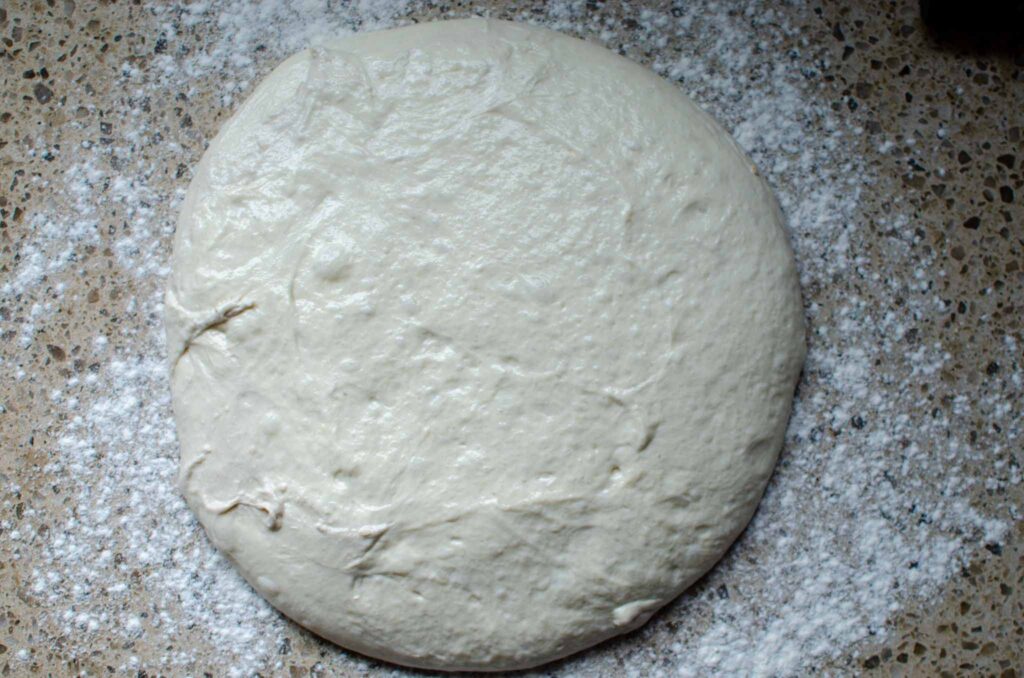
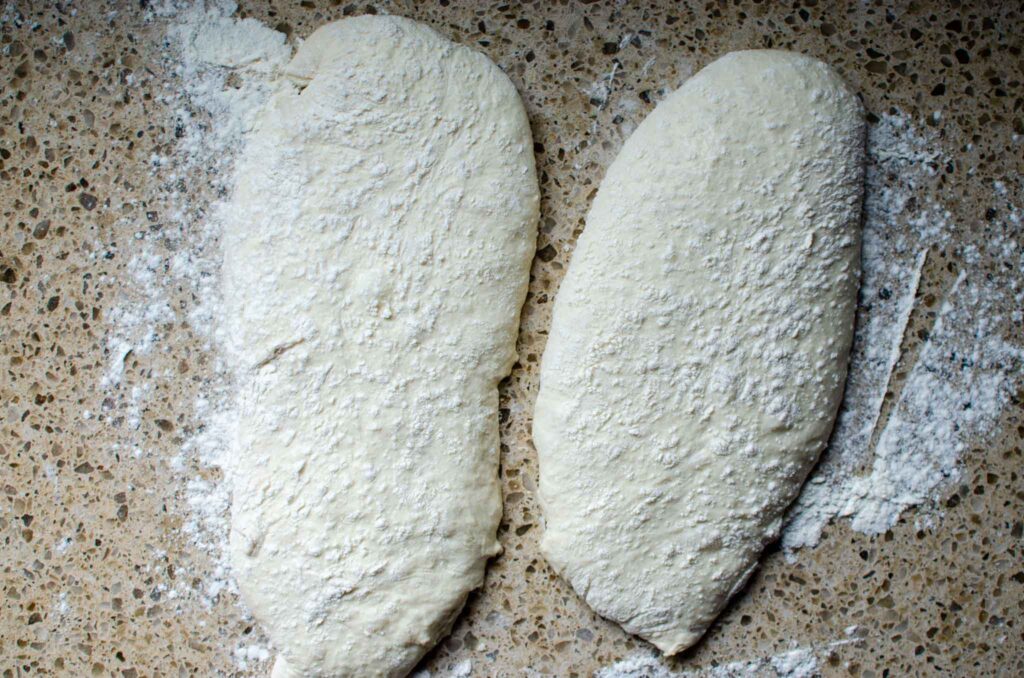
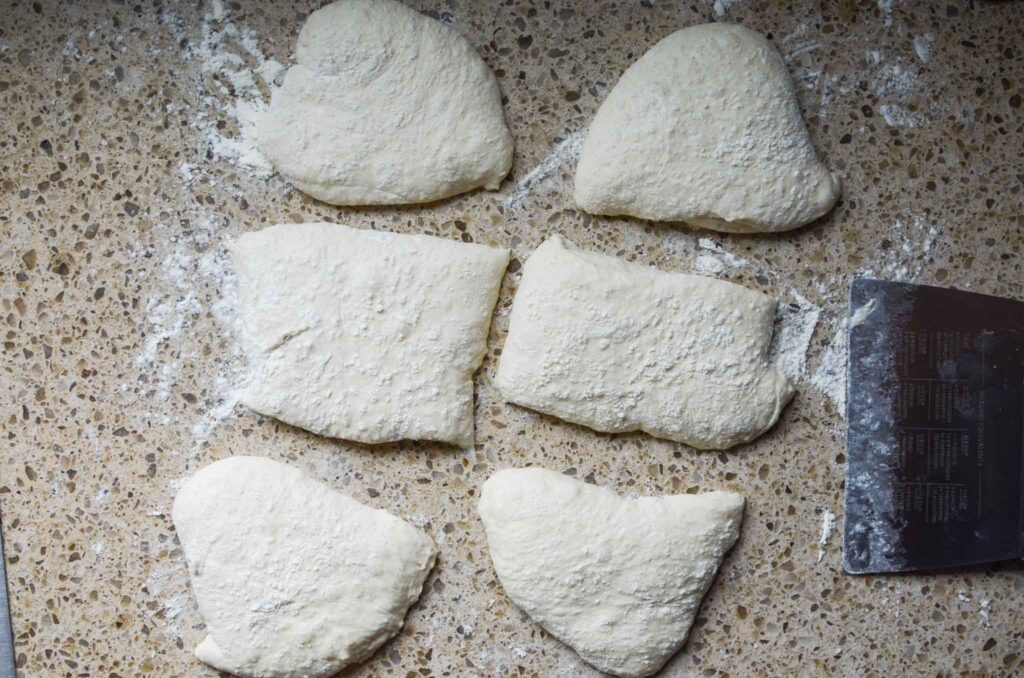
Final Proof
Cover the dough with a clean kitchen towel and rest on the counter at room temperature until you visibly see them puff up and develop a light and airy texture. This may take a bit, remember that the dough just came out of the fridge and it’s cold.
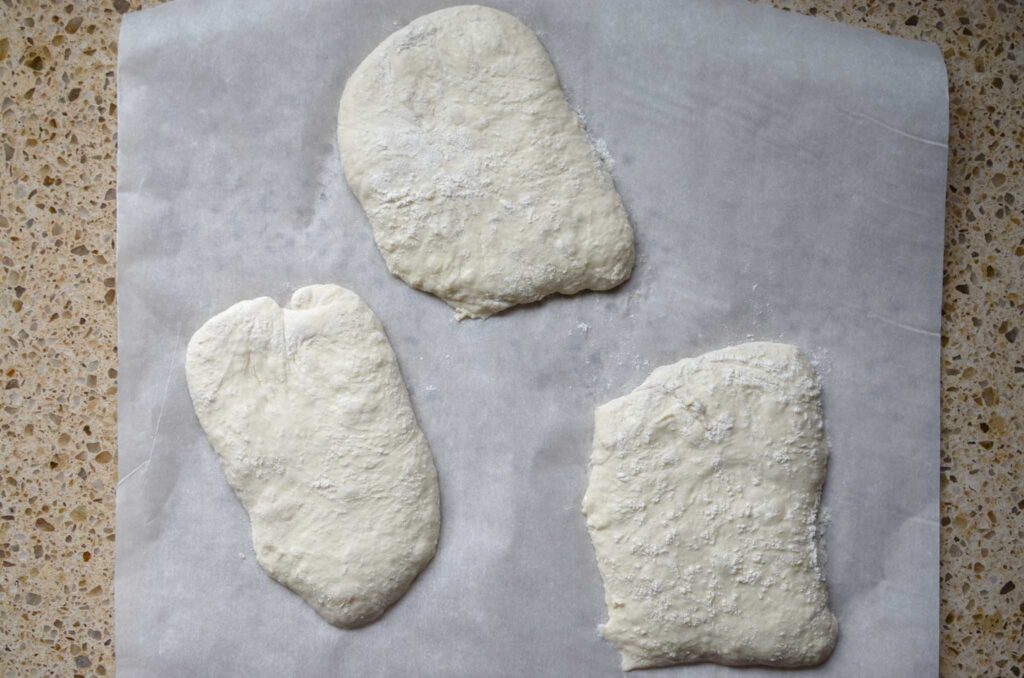
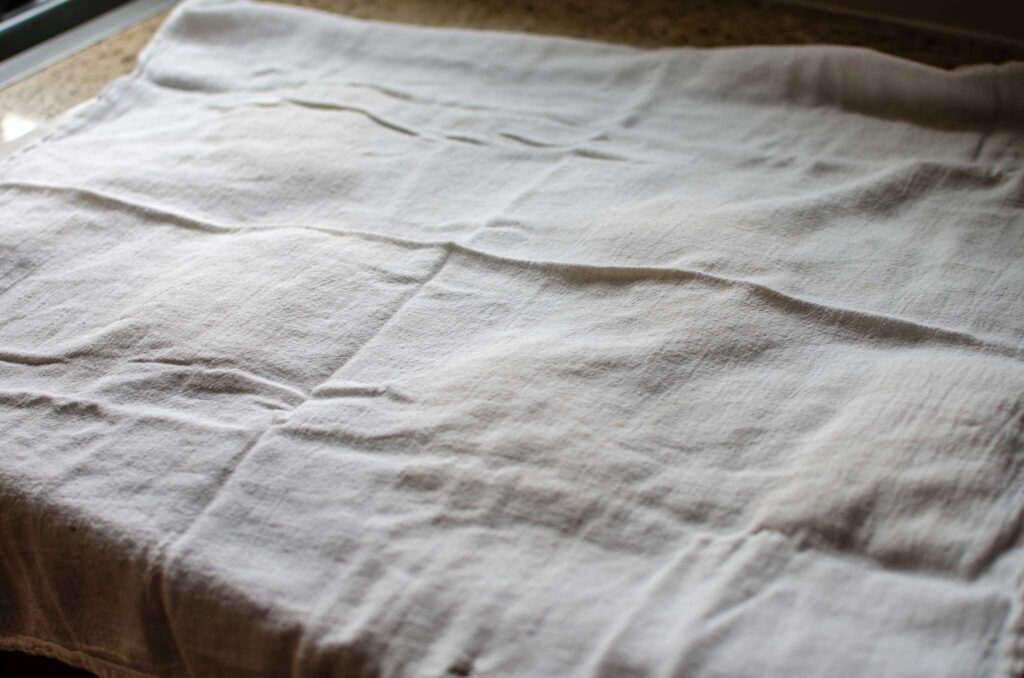
Preheat Oven
When the dough is ready, preheat the oven with a baking stone or pizza stone in it to 450 degrees for 45 minutes with a cast iron skillet on a lower rack.
Bake
Slide the parchment paper onto the baking sheet and then slide into the oven on the pizza peel. I used a baking sheet that didn’t have a raised edge, but you could use a pizza stone or a large cutting board. Quickly add water to the cast iron skillet and close the door to trap the steam. This will help the crust to form.
Bake for 25 minutes or until the ciabatta rolls are golden brown and have a crisp crust.

Place on a wire rack to cool completely.
Storage
These are best used the day they are baked. Once cut, store in an airtight container.
Tips for Making Sourdough Ciabatta
Use plenty of flour – With the hydration level in this dough so high, the highest I’ve worked with so far topping out at 82%, it makes the dough tricky to work with. It will be very sticky so you will want to generously flour your work surface, hands and the dough as you go.
It’s also a slack dough, wanting to flow and move any chance it gets. You will need to make quick, decisive motions when moving the bread. Thankfully there’s beauty in a rustic shape, and you can easily adjust the dough once it’s in its resting place.
Example Baking Schedule
Day 1
- 8 am – Feed starter
- 2:00pm – Autolyze – mix flour and water and let rest 30 minutes.
- 2:30pm – Mix dough – add salt and starter to autolyze, mix to combine.
- 2:45-3:25pm – Stretches and folds – 4-5 sets of stretch and folds with 10 minute rests in between.
- 3:25-9:30pm – Bulk Ferment (Time will vary)
- 9:30pm – Place dough in refrigerator for cold ferment.
Day 2
- 8:00am – Divide and shape the dough
- 8:15am – Final proof
- 9:00am – Preheat oven
- 10:00am – Bake
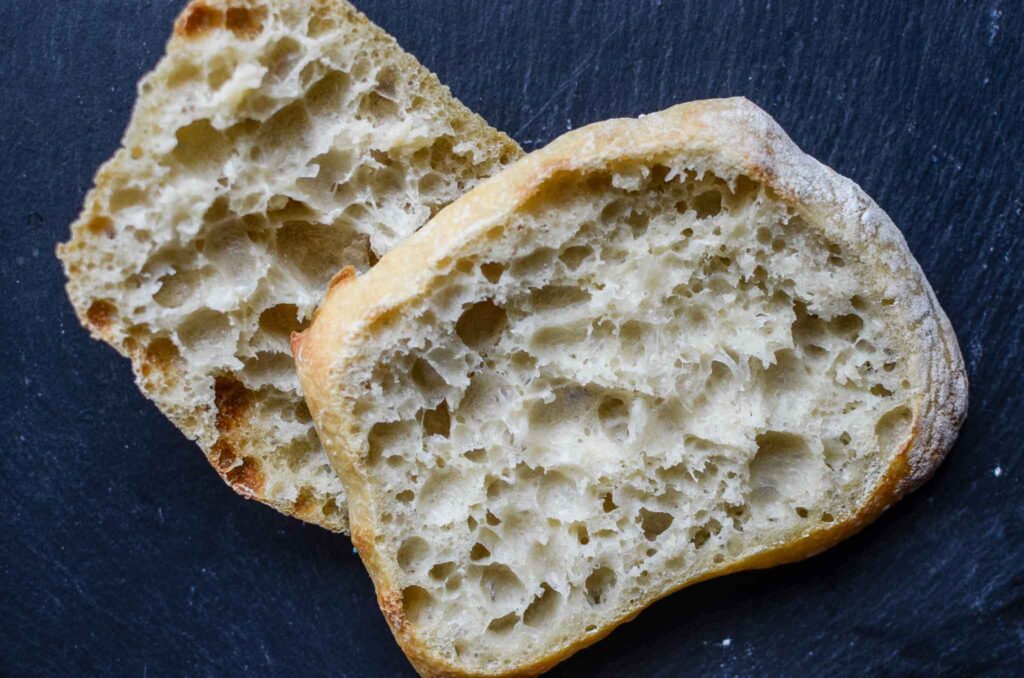
FAQs
Is Sourdough Ciabatta Healthy?
Sourdough ciabatta bread boasts all the benefits of sourdough. The long fermentation process breaks down the phytic acid found in grains, beans, and nuts. Phytic acid is an anti-nutrient that interferes with the absorption of certain nutrients. Once it’s broken down, our bodies can absorb more of the nutrients in sourdough breads and also makes them easier to digest. Fermenting it won’t completely eliminate the gluten, but it does greatly reduce it. Those with gluten sensitivities can often handle enjoying sourdough bread.
Sourdough vs. Ciabatta – What’s the Difference?
Sourdough ciabatta bread and sourdough bread have many similarities. Both are made of sourdough starter, flour, water, and salt, and have the benefit of long fermenting, making them easier to digest, but that is where their similarities end.
With ciabatta’s higher water level, its texture is light and airy with a crust that is thin and crisp. While being able to shape into a long, flat loaf, it can easily be made into individual rolls by parsing the dough out smaller. These make excellent sandwiches, with the perfect crust for holding your fixings together and a soft and tender texture making each bite worthy of taking another.
Sourdough bread has a thicker, chewier crust with a denser crumb than ciabatta. Sourdough bread loaves, often shaped in a round or oval loaf, can have such a range in hydration which will change how open the crumb is, whereas ciabatta always has high hydration..
What Do You Eat With Sourdough Ciabatta?
- Sourdough ciabatta is perfect to pair with a bowl of soup.
- Add a touch of salt, pepper, parmesan cheese, and Italian seasoning to olive oil and voila, you have a simple, delicious appetizer.
- Using sourdough ciabatta bread with homemade mayo takes your sandwiches up a notch, providing the structure to hold in all of the fixings with a soft, tender crumb. Use it for paninis or swap out hamburger buns for your next grill out.
You’ll find so many ways to use this yummy bread.
I’d love to hear from you! Please leave a comment and rate the recipe. Tag photos #Lockremhomestead over on Instagram to share your Sourdough Ciabatta Bread! I can’t wait to see them!
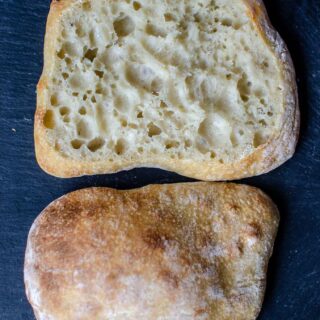
Easy Sourdough Ciabatta Bread Recipe
Ingredients
- 3½ cups bread flour 450 g
- 1½ cups warm water 360 g
- 2 tsp salt 12 g
- ½ cup sourdough starter 100 g
Instructions
Feed Starter
- You will need a ripe sourdough starter for this recipe. Feed the starter 4-8 hours before mixing your dough. The starter should show plenty of signs of life, be full of air bubbles, and have risen substantially. You know the starter is ready to use when it passes the float test. To do the float test, carefully take a teaspoon of the starter, trying not to knock any air bubbles out of it, and add it to a glass of water. If it floats, it’s ready. The starter has eaten and digested enough to produce carbon dioxide, thus making the starter full of gas and light enough to float.
Autolyse
- Mix the flour and water into a large mixing bowl, making sure to incorporate all the dry flour in the bottom and sides of the bowl. Cover and allow to rest for 30 minutes. This lets the flour properly hydrate.
Mix the Dough
- Add the rest of the ingredients to the autolyze and mix well. If mixing by hand, I find that doing a combination of stretch and folds, along with squeezing the dough, makes it easier to work the other ingredients into the autolyze. Continue to mix for a minute or two until all of the ingredients are mixed well and then let the dough rest for 10 minutes. A stand mixer makes quick work of this step instead of mixing by hand. Add the autolyze, starter, and salt to a stand mixing bowl and mix on medium for 10 minutes until the dough passes the windowpane test. It will be a smooth and elastic dough and stretchy when the gluten has been properly developed. Skip the stretches and folds if using the stand mixer.
Stretches and Folds
- Once rested, it’s time to start to stretch and fold the dough if mixing by hand. This is my preferred method, but it does take more time than using a stand mixer. Grab a side of the dough and stretch it straight up 6-8 inches and then fold it over to the center of the dough. Rotate the bowl a quarter turn and do another stretch and fold. Continue stretches and folds until all of the dough has been worked and starts to become stiff. Let the dough rest for 10 minutes and do another set of stretches and folds, performing 4-5 sets or until the windowpane test is passed. The dough will gain strength and elasticity with each set of folds. Use wet hands if you find that the dough is too sticky.
Window Pane Test
- To know if the gluten is fully developed and strong enough to hold the air pockets as well as provide structure to your bread, it will pass the window pane test. The dough is gently stretched in both hands up to the light. If you can stretch the dough thin enough that you can see through it, similar to a window pane, then it's ready. If the dough breaks before being able to stretch thin enough, the gluten development isn't quite there and it needs more stretch and folds.
Bulk Fermentation
- Once the dough passes the window pane test, cover the bowl with a tea towel, plate, or plastic wrap and allow it to rest at room temperature until it has risen by 50 percent. For me, it generally takes between 4-6 hours but this time will largely depend on the temperature of your kitchen. A warmer kitchen means the bulk fermentation time will be shorter.
Cold Ferment
- Move the dough to the refrigerator and allow to cold ferment for 8-12 hours or overnight.
Divide and Shape
- The next morning turn the dough out on a floured work surface, being careful to not knock out the air pockets with the sticky side up Gently pull the dough into a rectangular shape. It doesn't need to be perfect. Remember that this is a rustic bread and that the variety of shapes just adds some charm. Dust the tops of the dough with flour. Using a bench scraper or dough knife, divide the dough into 6 equal pieces. Alternatively, you can divide the dough down the center to create two loaves.Use the bench scraper to lift the ciabatta roll onto a piece of parchment paper, making sure to leave plenty of space for each roll to rise and spread. Gently shape each roll to a rectangular shape for more even baking, but don't fret over this step too much.
Final Proof
- Cover the dough with a clean kitchen towel and rest on the counter at room temperature until you visibly see them puff up and develop a light and airy texture. This may take a bit, remember that the dough just came out of the fridge and it is cold.
Preheat Oven
- When the dough is ready, preheat the oven with a baking stone or pizza stone in it to 450 degrees for 45 minutes with a cast iron skillet on a lower rack.
Bake
- Slide the parchment paper onto the baking sheet and then slide into the oven on the pizza stone. I used a baking sheet that didn't have a raised edge, but you could use a pizza peel or a large cutting board. Quickly add water to the cast iron skillet and close the door to trap the steam. This will help the crust to form.Bake for 25 minutes or until the ciabatta rolls are golden brown and have a crisp crust.Place on a wire rack to cool completely. These are best used the day they are baked. Once cut, store in an airtight container.

